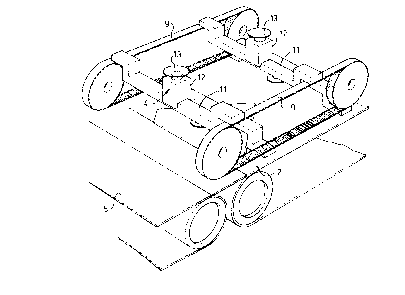Une partie des informations de ce site Web a été fournie par des sources externes. Le gouvernement du Canada n'assume aucune responsabilité concernant la précision, l'actualité ou la fiabilité des informations fournies par les sources externes. Les utilisateurs qui désirent employer cette information devraient consulter directement la source des informations. Le contenu fourni par les sources externes n'est pas assujetti aux exigences sur les langues officielles, la protection des renseignements personnels et l'accessibilité.
L'apparition de différences dans le texte et l'image des Revendications et de l'Abrégé dépend du moment auquel le document est publié. Les textes des Revendications et de l'Abrégé sont affichés :
| (12) Demande de brevet: | (11) CA 2219957 |
|---|---|
| (54) Titre français: | METHODE ET APPAREIL POUR PLACER DES OBJETS |
| (54) Titre anglais: | METHOD AND APPARATUS FOR POSITIONING OF ARTICLES |
| Statut: | Réputée abandonnée et au-delà du délai pour le rétablissement - en attente de la réponse à l’avis de communication rejetée |
| (51) Classification internationale des brevets (CIB): |
|
|---|---|
| (72) Inventeurs : |
|
| (73) Titulaires : |
|
| (71) Demandeurs : |
|
| (74) Agent: | SMART & BIGGAR LP |
| (74) Co-agent: | |
| (45) Délivré: | |
| (22) Date de dépôt: | 1997-11-03 |
| (41) Mise à la disponibilité du public: | 1998-05-04 |
| Licence disponible: | S.O. |
| Cédé au domaine public: | S.O. |
| (25) Langue des documents déposés: | Anglais |
| Traité de coopération en matière de brevets (PCT): | Non |
|---|
| (30) Données de priorité de la demande: | ||||||
|---|---|---|---|---|---|---|
|
Méthode et appareil pour placer des objets du genre dalle sur une bande transporteuse. Les objets sont déposés par le haut au moyen d'un dispositif pivotant se déplaçant avec la bande transporteuse, mais (au moins sur une partie du trajet) à une vitesse substantiellement inférieure à celle de la bande transporteuse. L'objet est déposé en un point éloigné de son centre de gravité et, si l'objet est triangulaire, de préférence sur une médiane du triangle.
Method and apparatus for positioning slab-like articles on a
conveyor belt. The articles are engaged from above by pivoting means
moving along with the conveyor but (at least over some part of the path
or travel) with a substantially lower speed than the conveyor. Engagement
of the article is effected on a point remote from the centre of gravity
and if the article is triangular preferably on a median thereof.
Note : Les revendications sont présentées dans la langue officielle dans laquelle elles ont été soumises.
Note : Les descriptions sont présentées dans la langue officielle dans laquelle elles ont été soumises.

2024-08-01 : Dans le cadre de la transition vers les Brevets de nouvelle génération (BNG), la base de données sur les brevets canadiens (BDBC) contient désormais un Historique d'événement plus détaillé, qui reproduit le Journal des événements de notre nouvelle solution interne.
Veuillez noter que les événements débutant par « Inactive : » se réfèrent à des événements qui ne sont plus utilisés dans notre nouvelle solution interne.
Pour une meilleure compréhension de l'état de la demande ou brevet qui figure sur cette page, la rubrique Mise en garde , et les descriptions de Brevet , Historique d'événement , Taxes périodiques et Historique des paiements devraient être consultées.
| Description | Date |
|---|---|
| Le délai pour l'annulation est expiré | 2003-11-03 |
| Demande non rétablie avant l'échéance | 2003-11-03 |
| Réputée abandonnée - omission de répondre à un avis sur les taxes pour le maintien en état | 2002-11-04 |
| Inactive : Abandon.-RE+surtaxe impayées-Corr envoyée | 2002-11-04 |
| Lettre envoyée | 2002-03-01 |
| Inactive : Correspondance - Transfert | 2002-01-29 |
| Inactive : Lettre officielle | 2002-01-02 |
| Demande publiée (accessible au public) | 1998-05-04 |
| Inactive : Transfert individuel | 1998-03-16 |
| Modification reçue - modification volontaire | 1998-03-16 |
| Inactive : Correspondance - Formalités | 1998-03-16 |
| Inactive : CIB en 1re position | 1998-03-05 |
| Symbole de classement modifié | 1998-02-24 |
| Inactive : CIB attribuée | 1998-02-24 |
| Inactive : CIB attribuée | 1998-02-24 |
| Inactive : Lettre de courtoisie - Preuve | 1998-02-03 |
| Inactive : Certificat de dépôt - Sans RE (Anglais) | 1998-01-27 |
| Exigences de dépôt - jugé conforme | 1998-01-27 |
| Demande reçue - nationale ordinaire | 1998-01-26 |
| Date d'abandonnement | Raison | Date de rétablissement |
|---|---|---|
| 2002-11-04 |
Le dernier paiement a été reçu le 2001-10-30
Avis : Si le paiement en totalité n'a pas été reçu au plus tard à la date indiquée, une taxe supplémentaire peut être imposée, soit une des taxes suivantes :
Veuillez vous référer à la page web des taxes sur les brevets de l'OPIC pour voir tous les montants actuels des taxes.
| Type de taxes | Anniversaire | Échéance | Date payée |
|---|---|---|---|
| Taxe pour le dépôt - générale | 1997-11-03 | ||
| Enregistrement d'un document | 1998-03-16 | ||
| TM (demande, 2e anniv.) - générale | 02 | 1999-11-03 | 1999-10-19 |
| TM (demande, 3e anniv.) - générale | 03 | 2000-11-02 | 2000-10-30 |
| TM (demande, 4e anniv.) - générale | 04 | 2001-11-05 | 2001-10-30 |
| Enregistrement d'un document | 2001-11-07 |
Les titulaires actuels et antérieures au dossier sont affichés en ordre alphabétique.
| Titulaires actuels au dossier |
|---|
| VAN DER ZON VAN DER WIEL, WILHELMINA JOHANNA CATHARINA MARIA |
| CSM NEDERLAND B.V. |
| Titulaires antérieures au dossier |
|---|
| PETRUS WILHELMUS MARIA (DECEASED) VAN DER ZON |